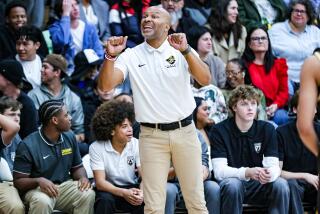Can CIF committees reshape the future of prep sports?

- Share via
It’s time for fine-tuning, creativity and some commonsense solutions.
The California Interscholastic Federation, which governs high school sports in the state, is holding a series of Zoom meetings next week with stakeholders entitled, “The CIF Commission for Strategic Priorities.”
Seven committees will begin the process of offering ideas, solutions and recommendations over issues involving athletic trainers, championship events/competitive equity, equity, mental/physical health of student athletes, officials, sportsmanship/fan behavior/discriminatory acts, and transfer eligibility/appeals.
There’s no guarantee anything will get done. When problems mount, the answer is always committees. Turning ideas into action is the hard part.
At least CIF executive director Ron Nocetti understands the status quo isn’t acceptable. To move forward and protect education-based high school sports, there must be continued progress in all seven areas.
“We continue to look for and commit to changes if changes are needed,” Nocetti said.
There’s lots of disagreements and frustration, and it’s not only a California thing. State associations across the country are facing many of the same challenges, particularly with transfers.
In Texas, where public schools have the most powerful voice and transferring for athletic reasons is not allowed, there’s talk of major changes after reaching 15,000 transfers in a year.
California long ago threw up the white flag of surrender on controlling athletic transfers, making it similar to the current status of college sports. Recruiting is still illegal in high school sports but largely unenforceable unless a parent steps forward on the record, which rarely happens.
The 10 section commissioners in California mostly offer the same comment that “only 2%” of high school students transfer or “98% of students don’t transfer.” Now that statewide transfers have exceeded 17,000 for the first time, they’re feeling some heat. It’s going to keep growing, and no one wants high school sports to become similar to AAU sports, where teams change weekly.
The CIF doesn’t like spending money on lawyers or dealing with lawsuits. That’s why transfer rules have gotten less strict, which combines with a philosophy of the state Legislature to encourage school choice. The fact private schools compete in the same leagues and in playoffs with public schools also keeps tensions high.
Everyone knows the landscape. Now it’s up to the committees made up of district representatives to figure a way forward. Hopefully, coaches, students and parents will participate in future committee meetings to offer their own ideas.
Schools want athletic trainers, but where’s the money going to come from to pay for them?
Competitive equity is here to stay, but what do you do with the small schools having to face big schools with little chance of succeeding?
Equity is important, but how can it be done with commonsense approaches?
Helping athletes’ mental health is a given, but what are the best ways and who will pay for it?
There’s a shortage of officials, but how can you attract more when schools don’t want to pay higher fees?
Sportsmanship and fan behavior have been addressed repeatedly for years — remember the Character Counts push? — but should punishment be increased?
The CIF is willing to listen and learn. That’s great. Let’s hope there’s also a commitment to take action. The perception from many is that pestering issues aren’t being addressed. This will be a start.
More to Read
Get our high school sports newsletter
Prep Rally is devoted to the SoCal high school sports experience, bringing you scores, stories and a behind-the-scenes look at what makes prep sports so popular.
You may occasionally receive promotional content from the Los Angeles Times.







